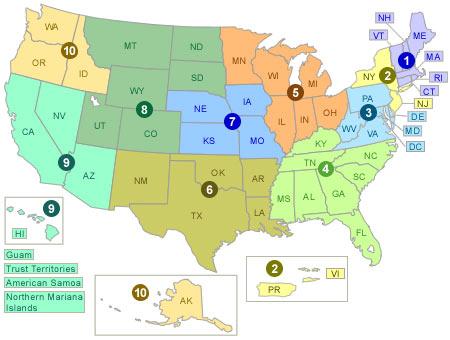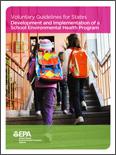Schools: Regional, Tribal, State and Local Resources for Healthier Schools
State Case Studies of School Environmental Health Programs
EPA's State School Environmental Health Guidelines offer case studies of successful, cost-effective state environmental health programs for schools that can be implemented by other states. Read the case studies.
Many states maintain websites with regulations and guidance for schools to implement and improve environmental health programs, policies and procedures. Even if you live in a different state or region, learning from the examples of others can help your efforts to improve your school's health and safety. Listed below are regional, tribal, state and local resources on healthy school environments.
On this page:
Resources in EPA regional offices:
- Region 1: Connecticut, Maine, Massachusetts, New Hampshire, Rhode Island, Vermont
- Region 2: New Jersey, New York; Puerto Rico, Virgin Islands
- Region 3: Delaware, District of Columbia, Maryland, Pennsylvania, Virginia, West Virginia
- Region 4: Alabama, Florida, Georgia, Kentucky, Mississippi, North Carolina, South Carolina, Tennessee
- Region 5: Illinois, Indiana, Michigan, Minnesota, Ohio, Wisconsin
- Region 6: Arkansas, Louisiana, New Mexico, Oklahoma, Texas
- Region 7: Iowa, Kansas, Missouri, Nebraska
- Region 8: Colorado, Montana, North Dakota, South Dakota, Utah, Wyoming
- Region 9: Arizona, California, Hawaii, Idaho, Nevada; Pacific Island Territories
- Region 10: Alaska, Oregon, Washington

- EPA's Healthy Schools Toolkit offers up-to-date, school-focused environmental health education information, including fact sheets and basic presentations on a range of topics, listings of local and national information sources and helpful contact information.
Tribal Resources
- Clean, Green and Healthy Tribal Schools provides resources to help tribal schools address environmental health issues. The website includes information on available workshops and webinars and links to relevant EPA programs.
- Tribal Schools Compliance Assistance Notebook provides quick access to the many programs and resources available to help prevent and resolve environmental issues in schools. The materials were gathered to assist tribal school districts and tribal schools in complying with federal laws and regulations and maintaining school facilities that are safe and healthy for students and staff.
The following links exit the site Exit
State and Local Resources
- Topics in School Environmental Health: Overview of State Laws Exitby the Environmental Law Institute provides a snapshot of how state policies have addressed several school indoor environmental quality issues—mold, radon, carbon monoxide, integrated pest management, vehicle idling, green cleaning, IAQ and renovations, and IAQ management plans.
- A Beginner's Guide to Reviewing EHS Issues at Your School developed by the Burlington (Massachusetts) Board of Health identifies 25 important items that should be reviewed and considered when initiating an environmental, health and safety (EHS) assessment.
- Brevard County (Florida) Public Schools Office of Environmental Health and Safety website describes the efforts of the custodial services team and presents tools and resources on a wide range of topics, such as asbestos, fire safety, hazardous materials, indoor air quality, integrated pest management, sanitation and more.
- The Green Schools Program operated by the Tennessee Department of Environment and Conservation strives to increase environmental education and literacy in schools and encourage environmental responsibility among citizens. The program addresses the areas of clean air quality, energy conservation, hazardous materials reduction, land and water conservation and solid waste reduction.
- The Green Schools section of the Massachusetts School Building Authority's website offers materials to encourage school districts to construct or renovate school buildings that will cost less to operate and will provide healthier learning environments for students.
- Greening Schools is a joint project of the Illinois Environmental Protection Agency and the Illinois Waste Management and Research Center. The website offers free technical assistance; workshops for teachers, administrators and facility managers; and online resources related to pollution prevention for all Illinois schools.
- Illinois's Healthy Schools for Healthy Learning interactive website lets you take the Schoolhouse Tour to explore environmental health in a variety of classrooms and other school locations. The website also offers regional reports, quizzes and other educational materials addressing indoor environmental quality, pests and chemical management.
- Michigan's Healthy School Action Tools provides an online assessment tool to examine issues such as asthma, nutrition, physical activity, tobacco use, violence and injury prevention, and social and emotional health. The website also includes a toolkit to create an action plan to help your school create a healthier school environment.
- New York State Education Department Office of Facilities Planning website contains a wide range of resources on environmental and occupational safety and health issues affecting school facilities.
- Oklahoma School Health Program provides leadership and coordination for preventive health and safety services to children and families through collaborative partnerships with other state agencies and organizations. Services provided include: policy and standards development, technical assistance, assessment, outreach, training and resource provision.
- Oregon Green Schools: School Resources on the Oregon Green Schools Association website helps principals, custodians, teachers, students, parents, kitchen staff, site councils, classified staff or school volunteers who are working on improving the health and livability of their school environment. Tools include audit and assessment materials, calculators, a glossary, lesson plans, field trip guides, activity books and a newsletter.
- The School Environmental Health and Safety section of the Washington State Department of Health website provides information on consultation, technical assistance and training available to local health jurisdictions, schools and parent groups on school health and safety issues. The website addresses biological issues, contaminants, indoor air quality, student health, safety and more.
- The Sustainable Schools section of California’s Division of the State Architect's website provides a diverse collection of resources to help schools create high performance educational facilities that will ensure the optimal health and productivity of students and faculty.

